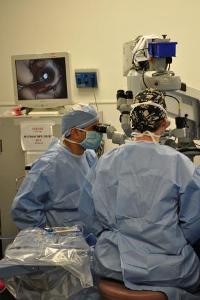Nov 28 2013
A tiny device is making a big difference in the lives of people with end-stage macular degeneration (AMD), the leading cause of blindness in people over the age of 65 according to the Centers for Disease Control and Prevention.
 Jay Lustbader, MD (seated right) and his Ophthalmology surgical team implant a miniature telescope into a patient with advanced macular degeneration at MedStar Georgetown University Hospital. (PRNewsFoto/MedStar Georgetown University Hospital)
Jay Lustbader, MD (seated right) and his Ophthalmology surgical team implant a miniature telescope into a patient with advanced macular degeneration at MedStar Georgetown University Hospital. (PRNewsFoto/MedStar Georgetown University Hospital)
"Macular degeneration is a disease of the retina where there is a change in the cells on the macula which is the center part of the retina," said Jay Lustbader, MD, Ophthalmology chair and director of Cornea and Refractive Surgery at MedStar Georgetown University Hospital. "In some patients the macula will scar in the center of the retina and result in a large blind spot in the central part of their vision."
Ann Montefusco of Clearwater, Florida has been legally blind for eight years due to macular degeneration. She is unable to see the faces of her loved ones, read a menu, drive a car or sign her own checks.
On October 2, 2013 Ann became one of the first people in the Washington, DC area to receive an implantable miniature telescope (IMT) at MedStar Georgetown University Hospital. The IMT was recently FDA approved for patients 75 and over and is part of a treatment program called CentraSight (www.CentraSight.com).
"I was so excited to have this done," said Ann. "I'm an avid golfer and I really look forward to being able to see normally again."
To implant the tiny telescope, Dr. Lustbader makes a 12 mm incision in the cornea of one eye, removes the lens and replaces it with the telescope implant. "The idea of the telescope is to magnify the view and make that blind spot smaller so patients can see. The eye with the telescope will replace their central vision, while the other eye will maintain the person's peripheral vision. In the weeks after the surgery patients perform eye exercises to learn how to balance the two fields of vision. "
CentraSight, which includes the implantation of the eye telescope, is a four-step program.
"First the patient receives the medical diagnosis of AMD," said Dr. Lustbader. "Then the patient is evaluated to see if the implantable telescope is likely to be successful. The surgery is next, followed by weeks of rehabilitation where the patient learns how to use their new vision."
"I am now working with my occupational therapist, learning how to use my new telescope," said Ann. "If I focus using the telescope everything is larger. Eventually my brain will work with me. I'm very encouraged."
The telescopic implant isn't for everyone. "Occupational therapy after the surgery can take three to four months," said Dr. Lustbader. "Patients must be motivated and committed to the therapy program after the surgery."
The CDC reports that an estimated 1.8 million people over 40 have macular degeneration and projects that age-related cases of AMD will double in people over 50 by 2050.